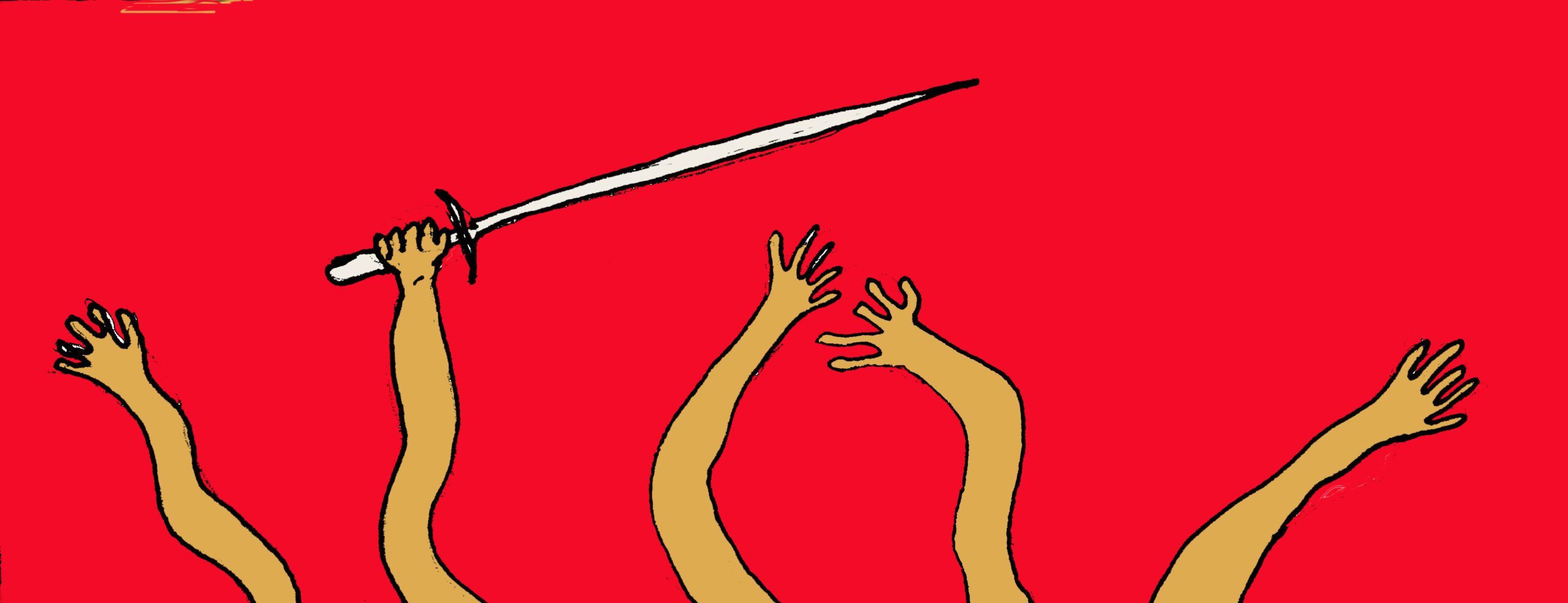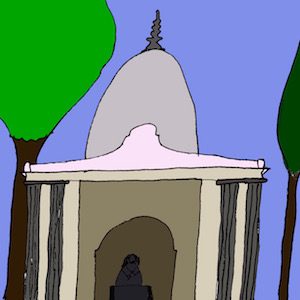
Although I never met her, I am told my great grandmother, Basantamayi, was a deeply religious woman. According to my grandfather, she and her husband, my great grandfather Bipin Chandra, lived in village Fatehabad, district Chittagong, in present day Bangladesh. Bipin Chandra worked in the Excise Department for the British government and his life revolved around books and erudition, while Basantamayi moored hers to the various gods and goddesses of the Hindu pantheon. She could recite lengthy verses from the epics Ramayana and Mahabharata purely from memory. She followed all the scriptural dictates of purity and pollution incumbent on high-caste Hindus, and performed domestic duties to perfection.
Basantamayi means “forever spring,” faintly ironic, considering she was married off at age ten to Bipin Chandra. He was twice her age. While to modern audiences this number might be preposterous, in her world it was already a year too late. Among high-caste Hindu families of Bengal at that time, the prescribed age for marriage for girls was nine. Unfortunately, Basantamayi’s parents were so dirt poor they had to wait a year to put together the minimum trousseau for their daughter.
Bipin Chandra and his parents were somewhat different from the norm. Not only did they not demand a dowry, they were also not perturbed by her “advanced” age. But other members of the extended family were not so kind. And so on her first day in her new home, ten-year-old Basantamayi, nervous bride, shy daughter-in-law, overheard complaints from a myriad of aunts, uncles, and neighbors: “Why this old hag for Bipin? Why waste such a gifted boy with someone like her? Surely there isn’t a drought of good, decent girls in Bengal?” In the midst of all that newness, homesickness, and attacks on her parents and family, I imagine Basantamayi sought the comfort of familiar objects. I imagine her tucked in a corner of the puja room, cloaked in the faint scent of sandalwood, the fading glow of the sun lighting up the faces of the gods and goddesses. I wonder if she reread her favorite stories from Hindu mythology, the ones in which the unjust are punished and the devoted are blessed, praised, and raised to the heavens.
*
My earliest memories of goddesses are from the year I turned four. A small temple, the size of a modest apartment, stood at the turn of our neighborhood in Calcutta. During the day, as I went back and forth from home to school accompanied by Ma or Baba, or fed the ducks at a nearby pond with my grandmother, the temple served as an identifying landmark, its dark interiors dimly visible from the street, and inside, the goddess Kali, shimmering like a shadow.
I would observe the priests, dressed in white cotton dhotis, their upper bodies bare, going about their daily chores, and guarding the goddess from the rest of us. At night though, she glowed under the white lights of the ceiling and in spite of the loud clamor of the brass bells, the blur from the hundred incense sticks, and the noisy traffic right outside the temple walls, her face was clearly visible and her eyes bored into mine: I see you, they warned, until I would break contact and look away.
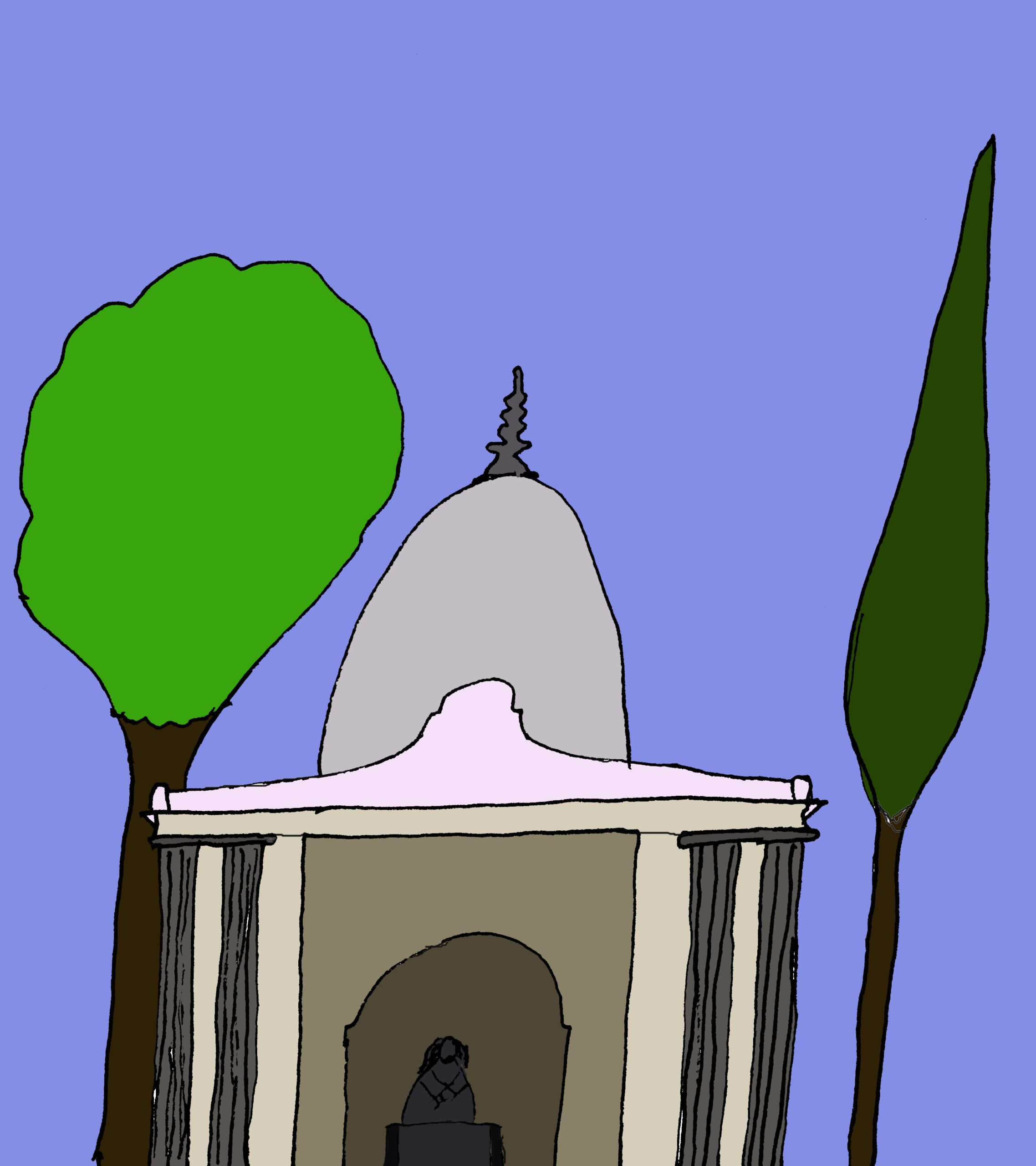 Ma said the goddess was watching over me because every minute of every day she saw everything and everyone. That sentiment, meant to comfort, did exactly the opposite. It made me uncomfortable. I didn’t want to be watched all the time. I wanted to be left alone to play my games, watch the neighbors, and make up stories about them in my head.
Ma said the goddess was watching over me because every minute of every day she saw everything and everyone. That sentiment, meant to comfort, did exactly the opposite. It made me uncomfortable. I didn’t want to be watched all the time. I wanted to be left alone to play my games, watch the neighbors, and make up stories about them in my head.
It was also Ma who taught me to pray: “Bring your hands together, yes, like that, dip your head a little, that’s the right way to do nomoshkar. Ask the goddess to bless you.” I did so without protest. I did so even though I didn’t really understand the meaning of blessings or their purpose.
It was around this time that my grandfather presented me with a comic book that contained five stories, each featuring one of the hundreds and thousands of goddesses that make up the Hindu pantheon. The first one was about Durga, the mother goddess.
*
I love that the story of Durga begins with a demon. His name is Mahishasura. He is a shape-shifter. He can turn himself into a buffalo at will. Mahishasura undergoes harsh penance to please Brahma, the god of creation. When Brahma appears before him and promises to grant him any boon he pleases, Mahishasura asks for immortality.
Brahma refuses. Immortality is for the gods, he says.
Mahishasura reconsiders. He makes another request: Grant me the boon that I may not be killed by any man.
Tathastu, says Brahma, so be it.
Mahishasura misunderstands the blessing. He translates Brahma’s words to mean he has attained immortality. To him, even the idea of being killed by a woman is as laughable as it is impossible. Drunk on his new power, he goes on a rampage. He kills innocents and destroys temples. He vanquishes kings and occupies kingdoms. Then he turns his attention toward the gods. So confident is he of victory that he marches toward the heavens. The gods panic. They call for a meeting. They combine their energies and from that infinite power, Durga is born. Her name means “the fortress.”
Each of her creators gives her a weapon. Ten arms, ten weapons. Shiva gifts her the trident, the chakra comes from Vishnu, so on and so forth. Thus armed, Durga sets out for Mahishasura. With her striking features, red sari, and gold ornaments, she is a stunning sight to behold. Mahishasura is so enraptured by her beauty that he offers her marriage. Durga smiles. She rejects him on account of her vow. She will only marry the man who can vanquish her in battle. Her words wound Mahishasura’s ego, and he launches his fiercest attack on her. He tries to trick Durga by turning into a buffalo. The battle rages on until the moment Durga pierces his heart, and thereby restores peace on earth. It is this final, dramatic moment of this story that is most loved and depicted by artists, and the context in which she is depicted on the cover of my comic book.
I still remember Durga in a green blouse and a red sari on the cover of my comic book, her long wild hair billowing like smoke. Her third eye was open, and her gold crown matched her numerous bracelets and necklace. She was astride her mount, a snarling lion with a thick mane. In each of her ten arms, she held weapons—a lasso, snake, sword, mace, bow and arrow, and an axe. A thick stream of blood dripped from her scimitar. Mahishasura’s skin was an unhealthy blue-green color. Half of his body was in the shape of a man and the other that of a buffalo. He lay at Durga’s feet. His eyes bulged and his neck, severed from the rest of his body, lay in a puddle of blood.
In spite of the ferociousness of the image, I don’t remember being scared, perhaps because the comic book was not my first introduction to Durga. By then, I had already seen her in calendars and wall art, in sculptures and icons in temples and shops, and inside people’s homes, molded out of terracotta, marble and granite, Styrofoam, gold and silver. I loved it all—the fierce story, the powerful goddess, and the fairy tale-like ending. I had no trouble in reposing my faith in any of these fantastic elements.
My questions began a few years later: Why doesn’t Durga answer back? Has anyone ever seen her talk? What does she sound like? What makes her different from the dolls I play with at home? Can I pray to them instead? How can you be so sure that those dolls are meant for play and Durga is for worship? How do you know she watches everyone and doesn’t snooze away her afternoons?
The older I got, the more I read and the more cynical my questions became. By this time, thanks to my father’s job, we had relocated to New Delhi from Calcutta, and here, no matter how many times I accompanied my mother to the temple, I refused to bow my head.
I clung to one Hindu ritual; however, the rest I quietly discarded. This too had been taught to me by mother. As a child, if I ever dropped a book or a notebook or a writing instrument, she would tell me to pick it up, touch it to my head, then heart, and ask for its forgiveness. She taught me that Saraswati, the goddess of learning in Hinduism, lives inside every article of education. As a child, this explanation made complete sense. As I grew older, so did its metaphorical meaning.
I also continued to participate in Durga Puja, the multi-day festival held every autumn to honor the goddess. To anyone who asked, I said, I am a social Hindu. Fortunately, I was not alone. In India, Durga Puja is probably one of those festivals that draws everyone, irrespective of their faith, or lack thereof. It offers an excellent time to connect with friends, family, and neighbors, to splurge on gifts and new clothes, and to indulge in traditional foods too decadent for the rest of the year.
*
I imagine the significance of Durga Puja must have been even greater during Basantamayi’s lifetime, when there were limited entertainment opportunities. Sports and cinema had not yet taken over the public mind, nor replaced the need and dependence on organized religion. I imagine that back then my great grandmother looked forward to Durga Puja more than even the village priests. Cloistered otherwise within the home, the festival offered an opportunity to travel—so what if the venue was the zamindar’s mansion located less than ten minutes away? It gave her, and others like her, the chance to observe village life, to meet other women, to laugh, giggle, comment on each other’s clothing and jewelry, to eat food cooked by someone else, and to watch plays and performances, even if that necessitated jostling for space behind a screen. Surely, the cumulative total of these experiences was priceless. They afforded my great grandmother an escape from daily chores, especially in her large, joint family where guests stayed for weeks, sometimes months. Granted, the chores were not hers alone, they were shared by other women, but still the opportunity to escape the daily drudgery must have been spectacular.
I wonder if on those days, when she eyed the shrine of Durga, it thrilled Basantamayi to see balding, wizened men bowing their heads to a young, beautiful woman. Did it please Basantamayi that they fasted in Durga’s honor and sang hymns in her praise?
*
It wasn’t until I left India for Idaho that I had to scrutinize my own position on Durga. Neither my secularism nor dismissal of faith had prepared me for my university students’ questions. The first time I pulled up an image of Durga to talk about Hindu iconography, my students gawked. “That is scary,” a blonde young woman whispered from the front row. Three young men, from a couple of seats behind her, said something under their breath and burst into giggles. A fourth, the intellectual of the class, raised his hand politely. When I nodded, he cleared his throat elaborately, paused for dramatic effect, and asked, “Professor, what is this?”
It shocked me to discover how much my students’ stares and jabs stung, how close I came to tears. It was as if I had allowed a beloved family member to be disrobed in front of a mob, and I was a mute bystander, a mere witness allowing relentless judgment and scrutiny on her person. Later, as I walked out of campus, it occurred to me that, in my offended state, I had ignored some genuinely smart and profound questions. For example, the anthropology major had asked if female priests assumed primary roles during Durga Puja. I had said, “No,” and to her follow up question, “Why not?” I had been unable to deliver a suitable answer.
In all the years I had attended Durga Puja, I had seen women perform secondary roles. They assisted the male priests. They cut fruits for the worship ceremony. They lit the incense. They held trays and passed them from one hand to the other. They blew conch shells. But they did not recite the classical Sanskrit mantras dedicated to the goddess. That power, that authority, lived in the vocal chords of men. I had always accepted that as normal. But now, thanks to my student, I was forced to confront the “normalcy” of a female-centric festival, controlled and operated by men. Clearly, I had much to learn about my own faith.
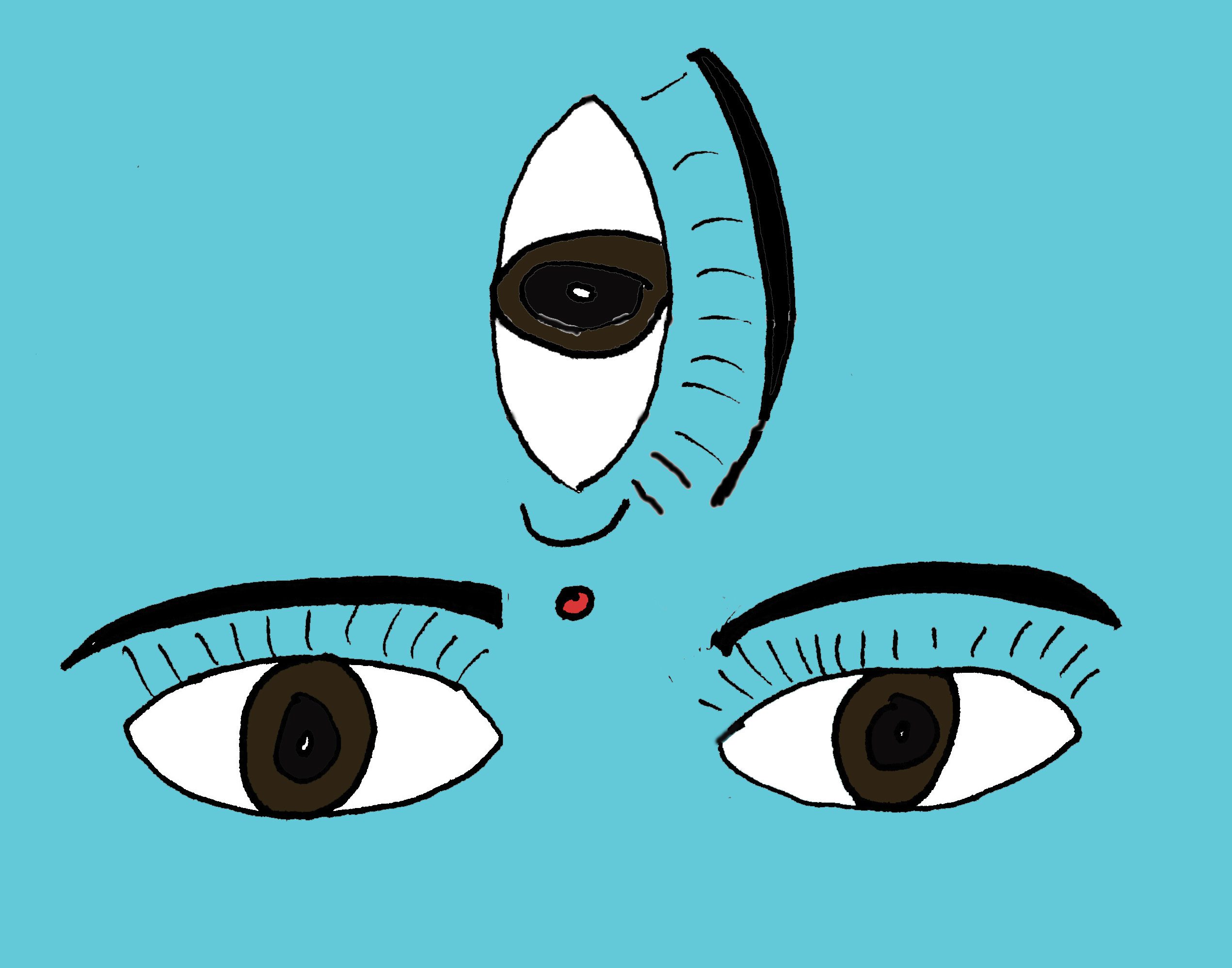 I remember I didn’t go straight home that evening. I went to my favorite café instead, where the humdrum of small-town Americana unfolded around me. I pulled up Durga’s most ubiquitous image on my laptop. Across from me, a middle-aged woman in a turquoise shirt tap-tap-tapped on her MacBook, pausing occasionally to rub the ring on her wedding finger. On my left, a muscular guy dressed in black sweatpants, cap, and sweatshirt, and with tattoos on the backs of both his hands, talked to his friends, all of them white and muscular and equally tattooed. At a table behind me, two girls chatted giddily about their new boyfriends. I stared at Durga’s image. For the first time in my life I saw her through the eyes of others. I counted all her “weird” features: the third eye, the ten arms, the waging of a battle from the back of a lion.
I remember I didn’t go straight home that evening. I went to my favorite café instead, where the humdrum of small-town Americana unfolded around me. I pulled up Durga’s most ubiquitous image on my laptop. Across from me, a middle-aged woman in a turquoise shirt tap-tap-tapped on her MacBook, pausing occasionally to rub the ring on her wedding finger. On my left, a muscular guy dressed in black sweatpants, cap, and sweatshirt, and with tattoos on the backs of both his hands, talked to his friends, all of them white and muscular and equally tattooed. At a table behind me, two girls chatted giddily about their new boyfriends. I stared at Durga’s image. For the first time in my life I saw her through the eyes of others. I counted all her “weird” features: the third eye, the ten arms, the waging of a battle from the back of a lion.
In the end, it turned out to be a useful exercise because it dredged up a long-forgotten memory of the first time I saw an image of Christ. I must have been about six years old and had only recently been admitted to St. Anthony’s, the Catholic school I would go on to attend for twelve years of my life. The sight of the scrawny man on the cross, bleeding and so obviously in pain, was horrifying, as was the gradual realization that in my school, there was no escaping him. He was everywhere. He stared at me inside classrooms, from various pieces of wall art, and from the rings and necklaces the nuns wore with pride.
I closed my laptop. I thought of words such as “contexts” and “perspectives.” The next morning, I checked out an armload of books from the university library. I had to learn to defend Durga.
*
Durga is what is called a “composite goddess.” She has one hundred and eight names. Each of these names is layered with complexity and meaning, and contains myths of its own. While no one can pinpoint the exact date of Durga’s creation or the hour when she was worshipped for the first time, this much can be safely ventured: her origins were tribal, she was worshipped by fringe populations who revered a mother goddess figure, and it took centuries for her transformation from a forest/tribal goddess into one firmly established in the Hindu cannon where she came to be worshipped by millions. As Devdutt Pattnaik points out in Devi: The Mother Goddess, before urbanization and the stifling influence of civilization, humanity depended on earthy mother goddesses for hope and nourishment. They tied their object of veneration with elements drawn from the plant and animal world. So there was the heron-faced Bagalamukhi, the turtle-riding Yamuna, the crocodile-riding Ganga, and Gayatri, the radiant goddess borne of a cow, among others. But the move out of the forest toward urban centers and a more settled form of life pushed people to move away from earthy divinity and look skyward in search of a father-god.
During the autumnal festival held in her honor, Durga is worshipped in nine different forms, one form for each day until she is immersed on the tenth day so she may undergo the cycle of renewal and rebirth that lies at the heart of Hinduism. The range of complexities within these nine forms is astonishing. While on the one hand she is Mahagauri, the dressed-in-white, icon-of-purity, on the other hand she is also Kaalratri, the violent and vengeful form. She is Shailaputri, the daughter of the mountains, a source of strength and spiritual standing, but also Brahmacharini, the hermit who inspires her devotees to lead simple lives. Chandraghanta is the warrior whose half-moon shaped bell strikes fear in the heart of her enemies, and through Siddhidaatri, she fulfills all aspirations.
*
This is a story I heard from my grandfather.
In 1948, my great grandmother became a mother-in-law for the fourth time. Her oldest daughter and the two sons who had followed her in the birth order had all gotten married in the last few years and had even gifted her with a few grandchildren. This time it was her youngest son, my grandfather, who got married. But unlike his siblings, he had done it all wrong. He had married a so-called low-caste girl. Granted, she was from the same village, but he had married her in secret, and in Calcutta, the nearest big city, where they had both gone, ostensibly, to pursue education. My grandfather’s actions so enraged my great grandmother that she bolted herself inside her room. She howled and beat her chest and when the newlyweds arrived for her blessings, she wailed to the skies, the way one might berate the universe after losing a child. She couldn’t imagine living with the shame her youngest son had brought upon his family. How could he do this? How could he sacrifice dignity for love?
When I first heard the story, I was fifteen and easily outraged. I couldn’t imagine a wedding causing so much grief. When I think of that incident now, I picture Basantamayi locked inside her room, beating her fists against a heavy mahogany bed, her uncombed hair a spider web on her face. She hears snatches of conversation filtering in from other parts of her home as the rest of the family nervously prepares to receive the newlyweds. Someone set up trays of rice and vermillion, another lights incense sticks and earthen lamps, a third decorates the threshold with garlands of marigolds and mango leaves, all of them trying to follow some semblance of the rituals even though they know these duties are not rightfully theirs. These are to be performed by the matriarch of the family.
*
Over the years, I have come to realize that telling and retelling the story of Durga brings me great joy, especially if I am doing so inside an American classroom, where female students say “sorry” almost nonstop. They say “sorry” to me and to everyone else. They do so irrespective of whether it’s a freshman class with thirty-five students or an upper division honors course capped at fifteen. They apologize when I meet them in smaller groups for conferences, and when they stop by my office hours. If two students start answering the same question at the same time, inevitably it is the female student who apologizes and looks stricken as if somehow she has crossed a line and ventured into an inviolate space where her presence is unwelcome. I have personally interceded several times to ensure they don’t prefix their questions or sentences with “sorry.” Once, a student apologized to me for no fault of her own but because I misspelled her name.
I tell my students that one of Durga’s greatest strengths is her unapologetic nature. When I was four and learning about Durga, I had no concept or understanding of feminism. But because iconography is the study of symbols and their meanings, I want to think that nearly three thousand years ago, at the time of the creation of her mythology, some Hindus did. The fact that she owes her creation to male energies is not unusual. Think Eve. Think Athena stepping out of Zeus’s head, fully grown and dressed in armor, when the smith god Hephaistos cracks it open with an axe.
I want to uphold the image of Durga as deeply feministic. I want to present her to my students as yet another face of feminism. Time and again, I have seen them hold the same stereotypical image of feminists—that they must be hairy, they must be lesbians averse to fine clothes, jewelry and makeup, and hateful toward men, families, and stay-at-home moms. I want them to know feminist icons don’t have to be white, and that they can be red-sari clad and with oodles of jewelry. So what if they are fantastic and mythical?
Recently, one of my female students wrote an essay on how the story of Durga has emboldened her to not hold herself back in her engineering classes, where often she is one of a mere handful of female students. I look upon this, the relevance of an ancient goddess from the mountains of north India, straight into a 21st century classroom in northern Idaho—a small but important victory.
*
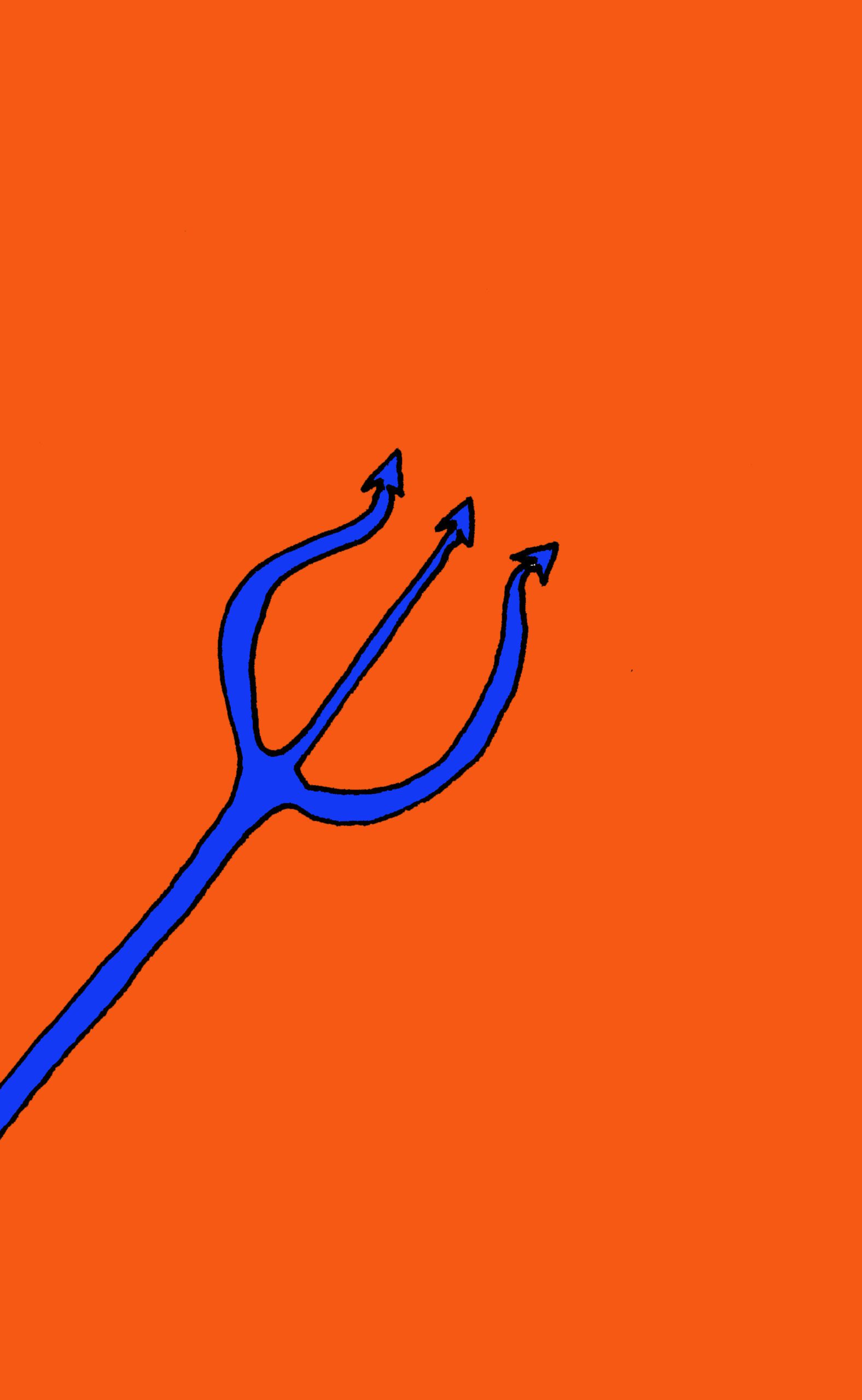 In India, Durga’s influence is not merely relegated to mythology or once-a-year-veneration of her prowess. Her influence shines through in folklore, in contemporary art and architecture. In cinema, she features either as a character or a metaphor: case in point, the Hindi film Mardaani. Released in 2014, it stars the powerhouse performer Rani Mukherji, essaying the role of a cop fighting a child trafficking mafia. The title of Mardaani means “man-like” and is a salutation used for Durga.
In India, Durga’s influence is not merely relegated to mythology or once-a-year-veneration of her prowess. Her influence shines through in folklore, in contemporary art and architecture. In cinema, she features either as a character or a metaphor: case in point, the Hindi film Mardaani. Released in 2014, it stars the powerhouse performer Rani Mukherji, essaying the role of a cop fighting a child trafficking mafia. The title of Mardaani means “man-like” and is a salutation used for Durga.
Sadly, our veneration of the powerful goddess does not eliminate our hypocrisy, and so while on the one hand Indian women continue to take huge strides in government, education, and private sectors such as banking and communication, the country still suffers from high rates of female infanticide, the culture of rape and dowry, and the inescapable hold of patriarchy in every aspect of life. Which is why, as Wendy Doniger notes in her controversial book The Hindus, “…the more powerful the goddess, the less power for real women.” In 2013, the Mumbai-based ad agency Taproot was commissioned by the NGO Save the Children India to run a campaign against domestic abuse and female trafficking. It was unnerving to see iconic images of Hindu goddesses—still beautifully adorned in gold jewelry and rich saris and bearing a plethora of sacred symbols like conches, lotuses, and tridents—recreated with black eyes, split lips, and bloodied noses.
*
These days, I find myself less outraged by my great grandmother Basantamayi’s actions. I remember the little say she had in terms of her own life and future, and the ease with which she was transferred like a commodity from her father to her husband. I count the things I know about her: that she was hospitable as long as the guests were high-caste Hindus; that she maintained a separate set of hookahs, and plates and cups, for Muslim visitors for fear of pollution. We are separated from each other by only two generations, and yet our differences could fill up a room. By age fifteen, Basantamayi was not just a wife, she was also a mother. She was still deeply wedded to her gods and goddesses. By the time I was fifteen, I had lost all inclination for prayer. I had dated two boys, gotten drunk, smoked a few cigarettes, bunked school, excelled and cheated in exams, and introduced comparatively innocent friends to porn.
I wonder if, in her mind, Basantamayi assumed that, just like the mothers in Hindu mythology, she too would command the unquestioning respect of her children, that they would give her the dignity she never received as a wife or daughter and obey her just the way she had obeyed her elders at age ten.
In her powerful essay, “What We Hunger For,” Roxane Gay writes:
I am always interested in the representations of strength in women, where that strength comes from, how it is called upon when it is needed most, and what it costs for a woman to be strong. All too often, representations of a woman’s strength overlook that cost.
I wonder, was Basantamayi’s grief and outright rejection of her new daughter-in-law an expression of strength? By denying her grief, did her family members deny her the agency to negotiate the world on her own terms?
I remember the outrage I felt when I learned how Basantamayi had humiliated my grandparents, back when they were newlyweds. But are Basantamayi and I really all that different? We both acted out defensively when repositories of our affection, deeply personal to us yet absurd to outsiders, were attacked, or we felt they were attacked. How could we withstand their debunking? Which makes me wonder if, in insisting that my female students follow my understanding of strength, I am denying them their own model of strength, of the codes they must create to understand, shape and engage with their world. After all, Durga too is not one single entity. She has 108 names.
In time, I learned from my grandfather that Basantamayi did overcome the resentment she felt against his wife, her youngest daughter-in-law. She came to love her grandson, my father. And she continued to love stories for as long as she lived. Meanwhile, I remain an atheist by faith, a Hindu in name and on officious-looking forms, and do not believe there are ten-armed goddesses hovering in the sky. Yet every time I drop a notebook or a book or a pencil, I pick it up with reverence, I touch it to my forehead, and plead for forgiveness. I remind my students what an incredible gift it is to be in college, inside a classroom. I tell them my story of being scared by the image of Christ on a cross, and I repeat the words “context” and “perspective” again and again so they remember not to dismiss someone’s objects of veneration and affection as “weird.”
Inside my apartment, Durga continues to live on in small tokens: a bookmark with the image of her third eye, a poster of a film in which she appears as a theme, a handful of books exploring the meaning behind her myths and icons, and occasional doodles on top of newspaper headlines. I hold her gaze the way a devotee might at the temple, mirroring the concept of Darsan or sacred sight in Hinduism, whose intended purpose is so the Divine may bless the recipient. We lock eyes until I break contact and look away.
***
Rumpus original art by Max Winter.

